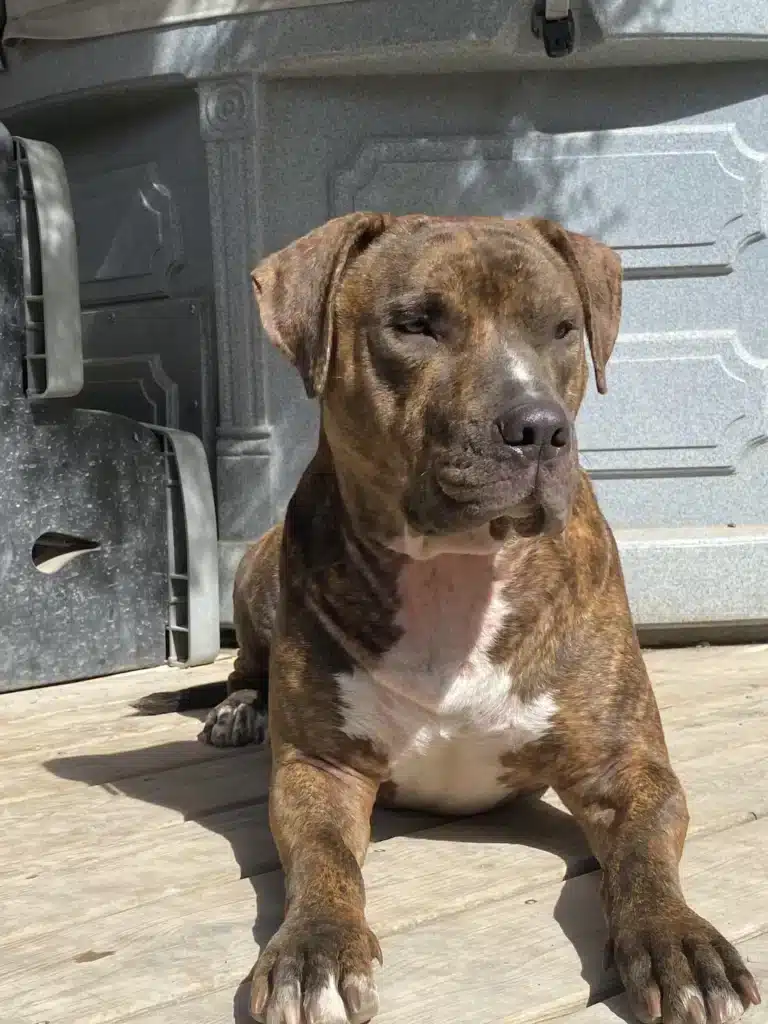Last Updated on May 26, 2024 by Amin Tawar
Brindle Pitbulls, while beloved by many avid fans of the breed, have one of the most fearsome reputations of any dog breeds. An umbrella term for several different kinds of dogs, they have a dark history (having been used for bullfighting in the past) and thus have a rep of being extra ferocious. Any dog lover will tell you that no dog and especially no breed is born vicious and it’s usually bad handling that causes them to lash out. But let’s take a look at a specific kind of pitbull – the Brindle Pitbull.
What Is a Brindle Pitbull?
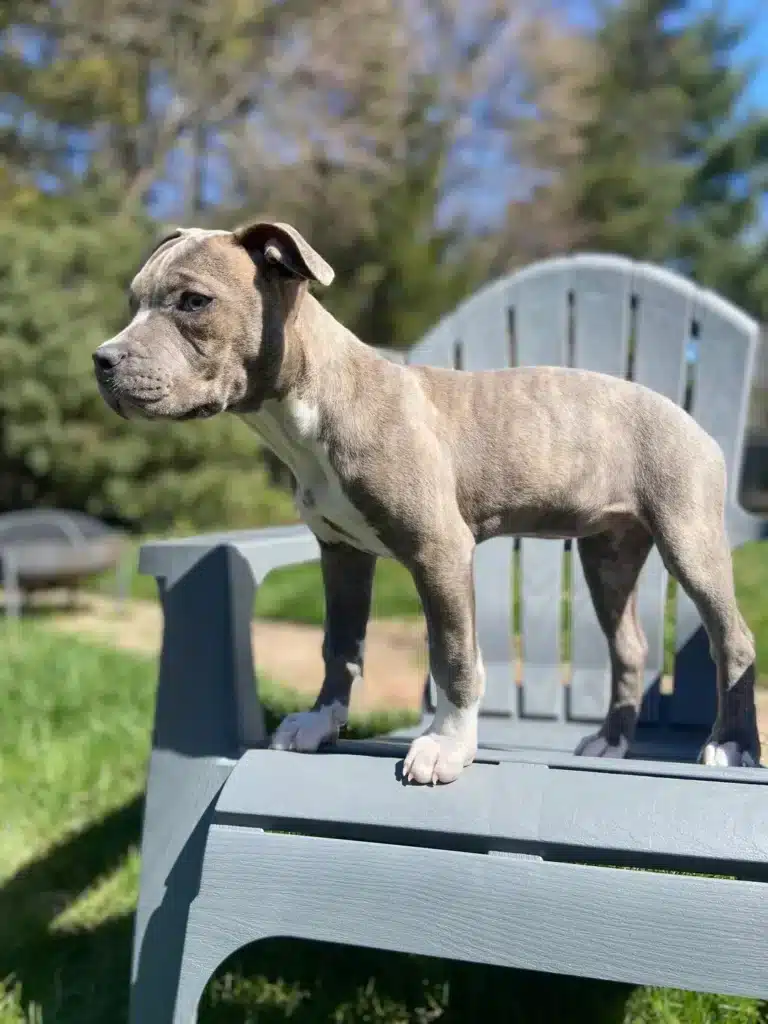
The Brindle Pitbull isn’t a breed or type of dog. No, they’re pitbulls with a specific kind of coloring. The ‘brindle’ coloring. Meanwhile, the term ‘pitbull’ too can vary although it usually refers to the American Pitbull Terrier although sometimes some other dog breeds are also thrown into that category. The American Pitbull Terrier is, interestingly, not recognized by the American Kennel Club. But we’ll come to that later.
What Does the ‘Brindle’ Coloring Mean Exactly?
‘Brindle’ is a coat pattern that several domesticated species sometimes have. It’s also called ‘tiger striped’ even though the stripes in a brindle coat aren’t as clearly demarcated as with a tiger’s stripes. Animals like dogs, cats, cattle, guinea pigs and occasionally even horses have a brindle pattern.
Brindle usually looks like dark brown or black stripes on a reddish background. It’s caused by the appearance of two different kinds of pigments in the coats – eumelanin (the black or brown pigment) and pheomelanin (the red or yellow pigment).
Brindle dogs also usually have white markings or tickings (ticking meaning when every individual strand of hair has different shades, lightening from root to end). Brindle markings are caused by very complex genetics so it’s virtually important to test and detect before it appears in a puppy.
Some dogs, as with Basenjis, have a pattern called trindle because they have tan in addition to black and red. Some dogs, such as the brindled Cairn Terrier, might become more black or silver as it ages with the brindle coloring becoming less and less marked.
The Dark History of Pitbulls As a Breed
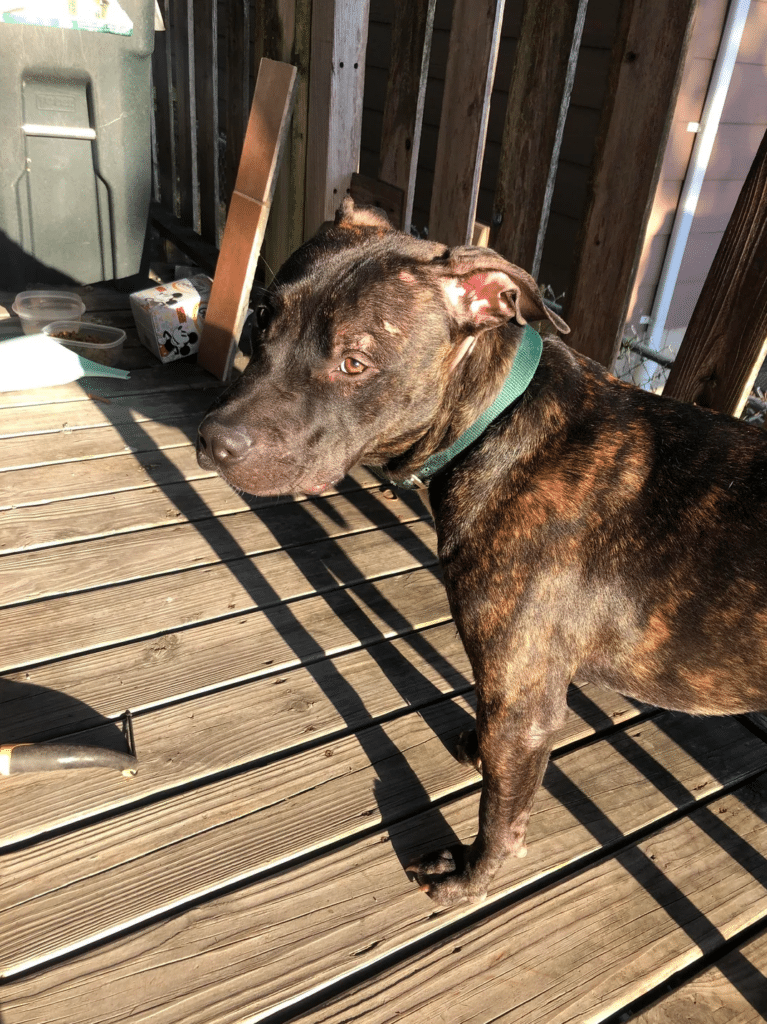
Now that we’ve understood what the brindle pitbull is exactly, it’s time to understand pitbulls as a breed. (Here we shall be talking about the American Pitbull Terrier alone even though other breeds also fall under the same category.) Unfortunately, these dogs have very sad origins. Descended from the bull and terrier cross breeds, the Pitbull was developed by crossing the Old English Bulldog and the Old English Terrier (both breeds are now extinct).
Developed in the United Kingdom for the most brutal kind of bloodsports like bull baiting and rat baiting, they sometimes took part in dogfights as well. They were created so that the heavy and muscular Old English Bulldog and the lithe and fast Old English Terrier came together to create a lighter, faster and more agile dog. They were imported to America where dog sports also became popular in the 19th century.
Eventually the barbaric sports were criminalized and pitbulls were trained to be guard dogs and to do other work like herd cattle, guard livestock, participate in dog sports like agility and flyball, detect narcotics as police dogs and work in search and rescue. They can also work as service dogs and therapy dogs. Basically, they’re pleased to do any jobs that are given to them.
Despite the criminalization of bloodsports, it has continued to be a popular pastime in the United States. Thousands of dogs are estimated to die in illegal dog fights every year and gangs often use Pitbulls to help with their criminal work.
The Popularization of Pitbulls
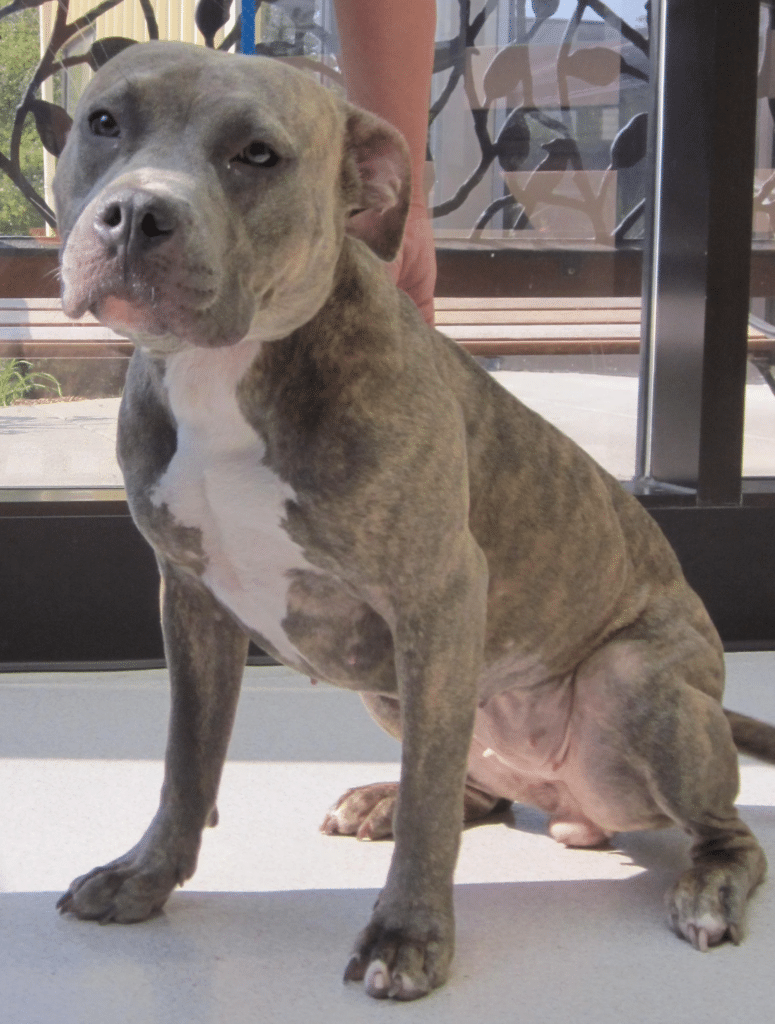
To this day, Pitbulls have a terrible reputation. They’re banned in several countries and are responsible for more bites and fatalities than any other dog breed. Having said that, we’re of the firm belief that there aren’t any bad dogs, only inefficient owners. Pitbulls might have a very bloody history but they’re generally very affectionate and loyal pets.
However, with more awareness, pitbulls have become very popular in recent years. Animal rights groups have spent a lot of time and effort trying to rebrand Pitbulls as ideal family dogs and shelters do their level best to get them adopted out. Sometimes they deliberately misidentify them to prevent euthanasia attempts.
In 2007, NFL quarterback Michael Vick was convicted of dog fighting. Sympathy for the Pitbull rose enormously. Of the 51 Pitbulls that were part of that racket, 48 were adopted out and rehabilitated. Sports newspapers and channels ran positive articles about the dogs and people learned that they were actually gentle, affectionate pets when given a chance.
Pitbulls have been historically famous. The most notable example is Stubby, a dog that served during World War I and helped capture a German spy. Star, a pitbull who was shot by the police while protecting her owner, went viral in a video. Pete the Pup was played by several Pitbull-type dogs in the film The Little Rascals.
Different Types of Pitbull Dogs
While ‘Pitbull’ is generally used to identify the American Pitbull Terrier, it is also a term used to refer to different dogs in the United States. These are the American Staffordshire Terrier, Staffordshire Bull Terrier, American Bully and sometimes the American Bulldog. In the UK, it refers to the American Pitbull Terrier specifically.
Part of the reason is because they come from the same stock. But in the case of AmStaffs and the Staffordshire Bull Terrier, it’s because kennel clubs needed to recognize the dog breed without encouraging the practice of bloodsports. Thus, they recognized those breeds as separate from the American Pitbull Terrier and banned their participation in bloodsports.
American Pitbull Terriers are recognized by a rival club to the AKC, the United Kennel Club. Formed by breeders in response to the AKC’s refusal to accept the American Pitbull Terrier, it originated in 1898. Thus, when we refer to pitbull-type dogs in the American context, we might refer to any of these breeds.
Size and Appearance of a Brindle Pitbull
Considered a medium-sized dog breed with a muscular and powerful build, the Brindle Pitbull is sturdy and hardy. A fully grown male pitbull stands about 18 – 21 inches (46 – 53 cm) at the shoulder and weighs about 35 – 60 lb (15 – 27 kg). Meanwhile, females are a little smaller, standing at 17 – 20 inches (43 – 51 cm). They weigh about 30 – 50 lb (13 – 22 kg).
They have short, stiff coats that don’t shed too much. Thus, the brindle pitbull needs minimal grooming. Their coats are of a brindle color, with the dark stripes on a reddish background. It can vary from a blue brindle pattern to a red brindle pattern. Caused by a recessive gene, the K Locus gene. Brindle is apparently the second most common pitbull color, with black being the most common and fawn being in third place.
A Brindle Pitbull usually has several colors in its coat – black, light brown, fawn, blue and red. The nose of the Brindle Pitbull might be blue or red, leading to two subcategories – the Blue Nose Brindle Pitbull and the Red Nose Brindle Pitbull. The tail is long, thick and tapering.
Temperament and Behavior of a Brindle Pitbull
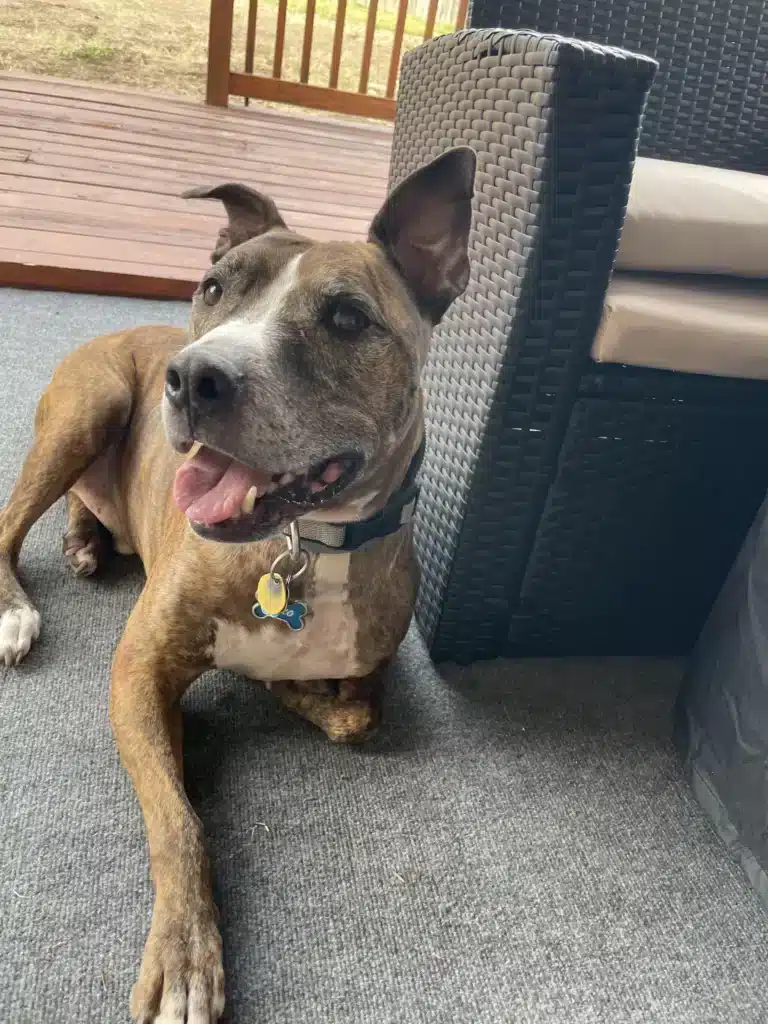
Anyone who has worked extensively with Pitbulls will tell you that a Brindle Pitbull taken into a loving home and properly socialized makes an excellent pet. Loyal and loving, Pitbulls are dogs that can obey orders and follow commands with a little training. They’re energetic dogs so they do well with active lifestyles. Leaving them alone at home and allowing them to get bored is a recipe for disaster since they might become destructive.
Although these dogs are fearless and have sharp instincts, most people will say that Pitbulls get along just fine with other dogs. Their brutal history might have left them with a stigma but when properly trained and disciplined, they’re protective and affectionate family pets. They’re always happy to have a job to do which makes them great working dogs and they’re eager to please.
Keep in mind that you’ll have to be consistent about training your Pitbull. Just the fact that they’re generally affectionate dogs shouldn’t make you complacent. They can be stubborn and they’re extremely powerful. So your command should be enough to get your dog to obey you.
Pitbulls are gentle with children and can often be very patient. They’re of a shorter stature than big dogs are so that helps the child get along well with a Pitbull. However, you shouldn’t leave them together unsupervised and you have to teach both parties to be gentle with one another.
Health of a Brindle Pitbull
This is a hardy and athletic breed so they’re generally quite hardy. In fact, Pitbulls live long as far as dog breeds are concerned, with an average of fifteen years. However, as with most dog breeds, they do have some problems. Some issues Brindle Pitbulls face are elbow and hip dysplasia, heart conditions, allergies, gastric torsion and thyroid disease.
An active lifestyle, regular check-ups with the vet and a proper diet should help control or prevent some of these diseases. It helps that they’re such an active breed and require so much exercise. Some illnesses are genetic, of course, but proper care and maintenance from the very beginning can help the symptoms from being very bad.
Exercise and Grooming Needs of a Brindle Pitbull
If you’re an active person who spends a lot of time outdoors and can take your dogs on daily walks, then the Pitbull would be a good companion for you. They don’t do well with small, enclosed apartments. They need outdoor yards where they can run around and play. And if you have time to play with them, all the better. Couch potatoes these dogs are not and if you aren’t very active then they’re not the right breed for you.
The first thing that people contemplating getting a Pitbull should know is that your carpets are safe from these dogs. Because of their short and wiry fur, they don’t shed much. This means that the grooming needs of a Pitbull are minimal. You can brush their fur from time to time (and you should since a grooming session is necessary bonding time with your dog). But a trip to the groomer’s is definitely unnecessary for this breed.
Check their ears and clean them out every couple of weeks and keep their nails trimmed so that they don’t catch or get hangnails. Other than that, a Pitbull is a low maintenance dog. You should also keep an eye on their diet as these dogs might get overweight if they eat too much. Consult your vet on the proper dietary needs of your Brindle Pitbulls.
Conclusion
And that’s all that you need to know about the Brindle Pitbull. I hope that this article was helpful and that you gained something valuable from it.
